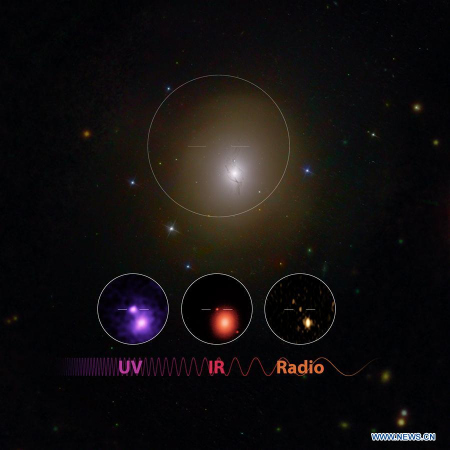
Image made by Caltech and NASA shows the UV/IR/Radio discovery of neutron star merger in NGC 4993. Scientists announced Monday that they have for the first time detected the ripples in space and time known as gravitational waves as well as light from a spectacular collision of two neutron stars. (Xinhua/Robert Hurt of Caltech, Mansi Kasliwal of Caltech, Gregg Hallinan of Caltech, Phil Evans of NASA and the GROWTH collaboration)
Scientists announced Monday that they have for the first time detected the ripples in space and time known as gravitational waves as well as light from a spectacular collision of two neutron stars.
Here are 10 key facts about the event known as GW170817, which triggered an international effort to observe the massive explosion that resulted from the collision.
1. For the first time, telescopes and gravitational wave observatories together witnessed the same astronomical event.
Telescopes observing across the gamma-ray, X-ray, optical, infrared, and radio spectra confirmed the source of GW170817 after its observation by twin detectors of the Laser Interferometer Gravitational-wave Observatory (LIGO).
2. This is the first time gravitational waves from the merger of binary neutron stars have been observed.
3. This observation is the first to definitively identify binary neutron star collisions as a source of short gamma-ray bursts. Theorized for many years, this is the first direct link between those phenomena.
4. This discovery is the first verification of a "kilonova" explosion, confirming binary neutron star collisions as one source for the universe's heaviest elements, such as gold and uranium.
5. This is the first binary neutron star pair confirmed outside of our own Milky Way galaxy, and this is the closest to Earth that astronomers have been seen a gamma ray burst.
6. The gravitational wave signals from GW170817 have enabled scientists to measure the expansion rate of the universe in a completely new way.
7. The partnership between LIGO and Italy-based Virgo allowed telescopes to rapidly turn their attention towards the area of sky where the neutron stars collided.
These telescopes identified the source as galaxy NGC4993, which is located 130 million light years from Earth in the constellation Hydra.
8. This event presents the strongest evidence to date for the detection of a gamma-ray burst off-axis, which means the cone emission from the explosion is not pointed directly at Earth.
9. The gravitational waves and light waves arrived within seconds of each other, suggesting they may travel at the same speed and confirming a prediction of Albert Einstein. The difference in detection time is likely a reflection of what happens during the explosion process.
10. Only gravitational wave observatories can directly detect unexploded binary neutron stars outside of our local galactic neighborhood, or directly observe the stars pre-collison, albeit only briefly before impact.


















































